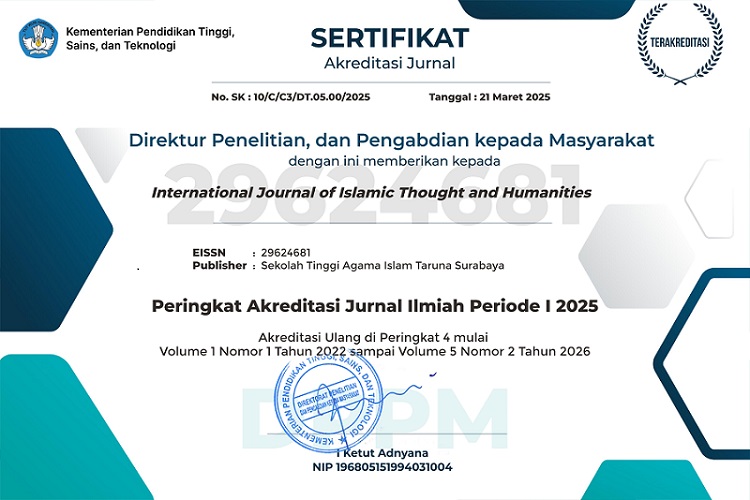Knowing Iblis: Study of Thematic Interpretation of Devil's Pride
DOI:
https://doi.org/10.54298/ijith.v1i1.14Keywords:
Iblis, Thematic Interpretation, Devil’s PrideAbstract
The controversy about Iblis as a "convicted" creature, cursed and expelled from various heavenly pleasures is a dramatic and perennial narrative in every divine religion. Since God proclaimed that he would create the first ruling creature on Earth [read Adam], Iblis not only presented himself as a dissident and seducer of Adam and his descendants, as the conclusion of the classical and modern interpretations above but also at the same time a symbol of negative predisposition or personification of crime, borrowing Rahman's term. This means that every form of crime committed by humans, whether in the form of murder, rape, waste, corruption, war, moral misconduct, etc., as often happens in various aspects of contemporary human life is the personification of modern Ibises.
Downloads
References
Achmad, A., Rahman, F., & Nuraripah, P. (2020). ṬABAṬABA’I INTERPRETATION ON PROPHETIC MISSION IN TAFSIR AL-MIZAN FOR THE CONSTRUCTION OF NUSANTARA SPIRITUAL CIVILIZATION. Teosofia: Indonesian Journal of Islamic Mysticism, 9(1). https://doi.org/10.21580/tos.v9i1.5328
Agostini, G. (2015). Herméneutique de la contingence - Mallarmé et gadamer. Germanisch-Romanische Monatsschrift, 65(3).
Ansari, A., & Qomarudin, A. (2021). Konsep Pendidikan Islam Menurut Ibnu Sina dan Ibnu Qayyim Al Jauziyyah. ISLAMIKA, 3(2). https://doi.org/10.36088/islamika.v3i2.1222
Aziz, A. K. (2017). SETAN DALAM ALQURAN (STUDI KRITIS TENTANG MAKNA SETAN PERSPEKTIF TAFSIR ANWAR Al-TANZIL WA ASRAR AL-TA’WIL). Diya Al-Afkar: Jurnal Studi Al-Quran Dan Al-Hadis, 5(02). https://doi.org/10.24235/sqh.v5i02.4349
Burge, S. R. (2021). The demystification of magic in the tafsīr al-manār: An analysis of the exegetical and homiletic devices used in the discussion ‘mabḥath al-siḥr wa-hārūt wa-mārūt.’ Religions, 12(9). https://doi.org/10.3390/rel12090734
Bustamar, B., & M Dalil, F. Y. (2020). Kronologis Kisah Nabi Adam As dalam Tafsir Ibn Katsir. Istinarah: Riset Keagamaan, Sosial Dan Budaya, 2(1). https://doi.org/10.31958/istinarah.v2i1.1813
Dikron, M., & Moh Saepudin, D. (2019). SIMPLIFITAS TAFSIR JAMI’ AL-BAYAN MIN KHULASHAT SUWAR ALQURAN KARYA KH. MUHAMMAD BIN SULAIMAN. Al-Bayan: Jurnal Studi Ilmu Al- Qur’an Dan Tafsir, 4(1). https://doi.org/10.15575/al-bayan.v4i1.5227
Duderija, A. (2018). The Theological Thought of Fazlur Rahman: A Modern Mutakallim. American Journal of Islam and Society, 35(4). https://doi.org/10.35632/ajis.v35i4.480
Mashaqbeh, H. N., & Jalal, Y. A. (2020). The Effect of Envy on the Emergence of Crime from a Quranic Perspective-The Story of Satan and Adam as a Model. Jordan Journal of Islamic Studies, 16(4), 17.
Qurrotul Aini, A. (2016). “Pertemuan Dua Laut Dalam QS. ar-Rahmān (Analisis QS. ar-Rahmān [55] Ayat 19-22 Menurut Fakhruddin ar-Rāzī Dalam Kitab Tafsīr Mafātīḥ al-Gaib). In skripsi.
Saifunnuha, M., Kusmana, K., & Bahri, M. (2020). The Discourse of Syurut al-Mufassir Among Traditional and Modern Scholars: A Content Analysis. https://doi.org/10.4108/eai.7-11-2019.2294536
Sakat, A. A., Masruri, M., Dakir, J., & Wan Abdullah, W. N. (2015). The jinn, devil and Satan: A review on Qur’anic concept. Mediterranean Journal of Social Sciences, 6(5S1). https://doi.org/10.5901/mjss.2015.v6n5s1p540
Santi Aji, T., & Yusron, A. (2022). Leadership Education Based on the Jamaah Concept in Sayyid Qutb’s Tafsir Fî Zhilâl Al-Qur’ân. Hayula: Indonesian Journal of Multidisciplinary Islamic Studies, 6(1). https://doi.org/10.21009/hayula.006.01.02
Setio, B. (2021). Implementation of Mufassir ’ S Terms in the Digital. Al-Mutsla : Jurnal Ilmu-Ilmu Keislaman Dan Kemasyarakatan, 3(1).
Siregar, M. S. A. (2018). Lubâb At-Ta’wîl ‘Inda Al-Imâm Al-Khâzîn Baina Al-Ma’tsûr wa Ar-Ra’yi (Dirâsah Maudhu’iyyah fi Ayah al-Qashash). Studia Quranika, 2(2). https://doi.org/10.21111/studiquran.v2i2.1783
Swist, J. J. (2019). Satan’s empire: Ancient rome’s anti-christian appeal in extreme metal. Metal Music Studies, 5(1). https://doi.org/10.1386/mms.5.1.35_1
Thahir, L. (2020). THE NEW THEOLOGY: CONSTRUCTING CRITICAL ISLAMIC THEOLOGY BASED ON HEGEL’S DIALECTIC THEORY. HUNAFA: Jurnal Studia Islamika, 17(1). https://doi.org/10.24239/jsi.v17i1.585.84-103
Downloads
Published
How to Cite
Issue
Section
License
Copyright (c) 2022 Achmad Achmad

This work is licensed under a Creative Commons Attribution-ShareAlike 4.0 International License.
Authors who publish with this journal agree to the following terms:
- Authors retain copyright and grant the journal right of first publication with the work simultaneously licensed under a Creative Commons Attribution-ShareAlike 4.0 that allows others to share the work with an acknowledgement of the work's authorship and initial publication in this journal.
- Authors are able to enter into separate, additional contractual arrangements for the non-exclusive distribution of the journal's published version of the work (e.g., post it to an institutional repository or publish it in a book), with an acknowledgement of its initial publication in this journal.
- Authors are permitted and encouraged to post their work online (e.g., in institutional repositories or on their website) prior to and during the submission process, as it can lead to productive exchanges, as well as earlier and greater citation of published work (See The Effect of Open Access).


















